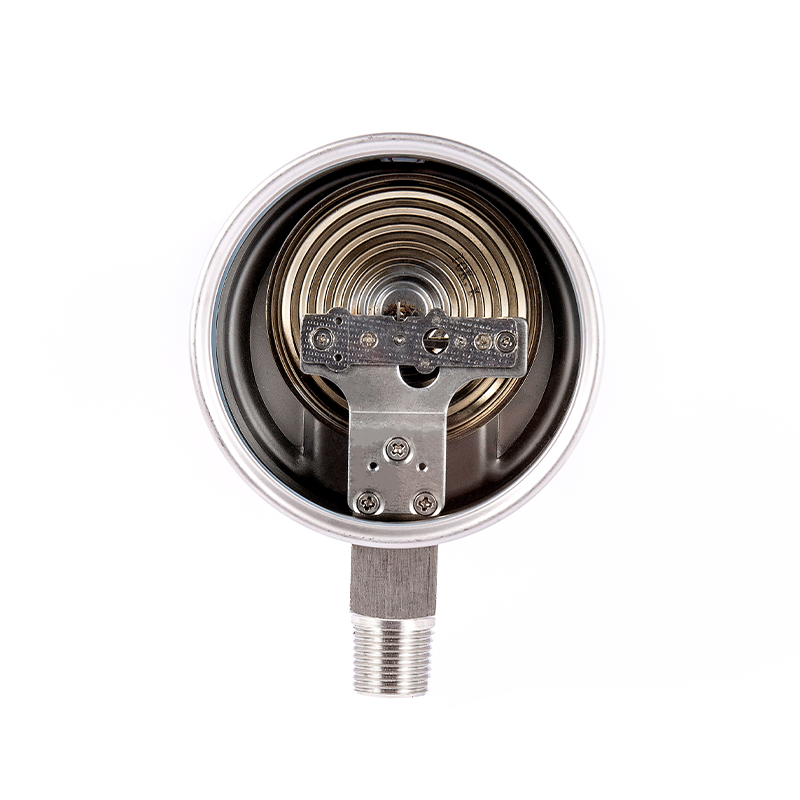YE series micro pressure gauges/membrane box pressure gauge
Cat:Pressure Gauge
◆ Model:YE60 YE100 YE150 ◆ Use: Membrane box pressure gauge is also called micro pressure gauge....
See DetailsIn the field of low-pressure measurement,capsule pressure gauge have a significant position due to their high accuracy and stability. Whether it is for monitoring low pressure in gas pipelines, ventilation systems, or chemical reaction vessels, their presence can be seen everywhere. Today, let's delve into the model meanings, structural composition, and material selection of capsule pressure gauges in detail. 
Capsule Pressure Gauge: Model
Basic model: Starts with "YE", where "Y" stands for pressure gauge, and "E" specifically refers to the diaphragm structure (distinct from the "Y" in ordinary spring tube pressure gauges).
Dial diameter: The number immediately following the basic serial number indicates the dial diameter (unit: mm). For example, YE-100 means the dial diameter is 100mm, while YE-150 is 150mm. The larger the dial, the higher the reading accuracy, making it suitable for scenarios requiring long-distance observation.
Special Function Identifier: Some models will have additional letters indicating special functions. For example, in "YE-100B", the "B" may indicate a stainless steel material with edges; in "YE-100Z", the "Z" indicates axial installation (default is radial installation).
For example: "YE-100BZ" indicates "Stainless steel material, dial diameter 100mm, axial-mounted capsule pressure gauge". Just by looking at the model number, you can quickly determine if it meets your usage requirements.
Structural Division Of Capsule Pressure Gauge
Although the capsule pressure gauge is not large in size, its internal structure is ingeniously designed, and all components work together to achieve precise measurement of low pressure.
Core measuring element: Capsule
It is formed by welding the edges of two metal diaphragms (usually made of copper alloy or stainless steel), creating a sealed flat circular box. When the measured medium enters the diaphragm box, the diaphragm will undergo elastic deformation (expansion or contraction) due to the pressure effect. This is the "source of power" for pressure measurement.
Transmission mechanism: Amplifies tiny displacements
The deformation of the diaphragm is extremely small. It needs to be amplified through transmission mechanisms such as connecting rods and gears before it can drive the pointer to rotate. This process is similar to the "lever principle", converting tiny pressure changes into visible pointer displacement.
Indication system: Visually presents pressure values
It includes pointers and dials. The scale units are mostly KPa (kilopascals) or MPa (megapascals, commonly used for low-range applications). Some special models may also indicate units such as bar, facilitating reading in different scenarios.
Shell and Connections
The outer shell protects the internal components and also serves the functions of dust-proof and moisture-proof; the connectors are used to connect the measured pipeline, introducing the medium pressure into the capsule. The interface specifications such as (M20*1.5) need to match the pipeline.

Material selection and application scenarios
The material of the diaphragm pressure gauge directly affects its corrosiveness, service life and applicable environment. When choosing it, one should take into account the characteristics of the measured medium.
1. Membrane box material:
Copper alloy: Low cost and good elasticity, suitable for measuring non-corrosive gases (such as air, nitrogen) or neutral liquids.
Stainless steel: Exhibits strong corrosion resistance and can be used to measure media with trace corrosive substances (such as slightly acidic gases, steam in humid environments). It is more durable in chemical industries, coastal areas, etc.
2. Shell material:
Ordinary carbon steel: Surface treated with paint, low cost, suitable for dry and non-corrosive indoor environments.
Stainless steel: Higher protection level, capable of resisting moisture, dust and mild corrosive gases, suitable for outdoor or harsh environments.
3. Sealing material:
The sealing between the joint and the housing is usually done using nitrile rubber or silicone rubber. Nitrile rubber has good oil resistance, while silicone rubber is more resistant to high temperatures. The choice of material can be made based on the temperature and characteristics of the medium.

Although capsule pressure gauges are mainly used in "low-pressure fields", they are indispensable in industries such as gas safety, environmental monitoring, and food processing. To make the most of their value in the right position, it is necessary to understand their model meanings, grasp the structural principles, and select the appropriate materials. Next time when purchasing, you can refer to this guide to easily find the suitable model!